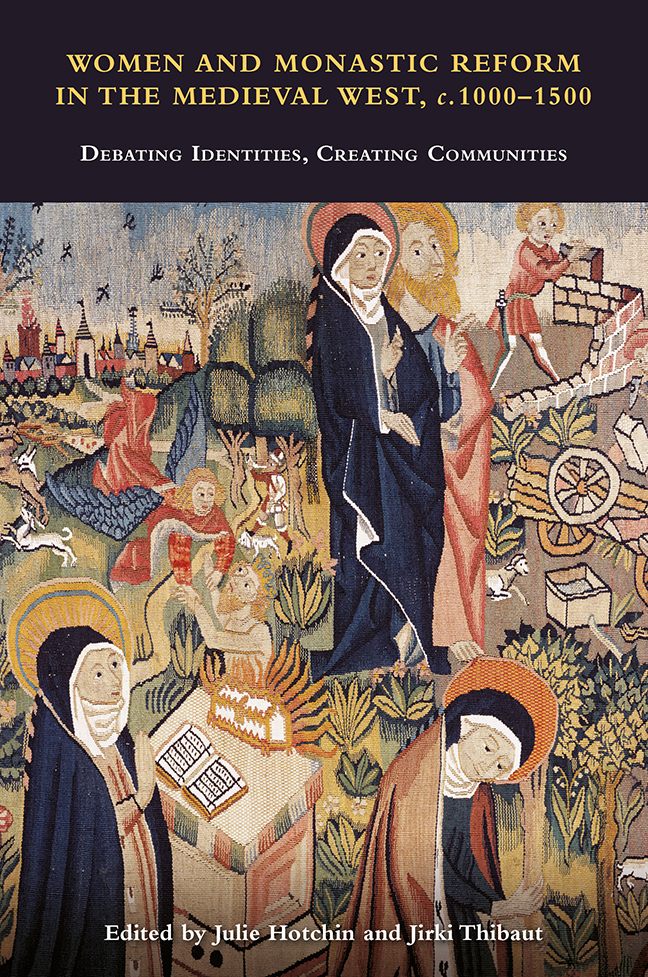 Women and Monastic Reform in the Medieval West, c.1000-1500
Women and Monastic Reform in the Medieval West, c.1000-1500 Book contents
- Frontmatter
- Dedication
- Contents
- List of Illustrations
- List of Contributors
- Acknowledgements
- List of Abbreviations
- 1 Debating Identities: Women and Monastic Reform in the Medieval West, c. 1000–1500
- 2 Liturgy and Female Monastic Hagiography Around the Year 1000: A lecture croisée of the Life of Liutrud, the Second Life of Glodesind of Metz and the So-called Pontificale Romano-Germanicum
- 3 Remakers of Reform: The Women Religious of Leominster and their Prayerbook
- 4 The Materiality of Female Religious Reform in Twelfth-Century Ireland: The Case of Co-located Religious Houses
- 5 Women as Witnesses: Picturing Gender and Spiritual Identity in a Twelfth-Century Embroidered Fragment from Northern Germany
- 6 Mulieres religiose and Cistercian Nuns in Northern Italy in the Thirteenth Century: A Choice of ‘Order’
- 7 Circulation of Books and Reform Ideas between Female Monasteries in Medieval Castile: From Twelfth-Century Cistercians to the Observant Reform
- 8 Women, Men and Local Monasticism in Late Medieval Bologna
- 9 Building Community: Material Concerns in the Fifteenth-Century Monastic Reform
- 10 Who Made Reform Visible? Male and Female Agency in Changing Visual Culture
- 11 Nuns, Cistercian Chant and Observant Reform in the Southern Low Countries
- Index
- Other volumes in Studies in the History of Medieval Religion
8 - Women, Men and Local Monasticism in Late Medieval Bologna
- Frontmatter
- Dedication
- Contents
- List of Illustrations
- List of Contributors
- Acknowledgements
- List of Abbreviations
- 1 Debating Identities: Women and Monastic Reform in the Medieval West, c. 1000–1500
- 2 Liturgy and Female Monastic Hagiography Around the Year 1000: A lecture croisée of the Life of Liutrud, the Second Life of Glodesind of Metz and the So-called Pontificale Romano-Germanicum
- 3 Remakers of Reform: The Women Religious of Leominster and their Prayerbook
- 4 The Materiality of Female Religious Reform in Twelfth-Century Ireland: The Case of Co-located Religious Houses
- 5 Women as Witnesses: Picturing Gender and Spiritual Identity in a Twelfth-Century Embroidered Fragment from Northern Germany
- 6 Mulieres religiose and Cistercian Nuns in Northern Italy in the Thirteenth Century: A Choice of ‘Order’
- 7 Circulation of Books and Reform Ideas between Female Monasteries in Medieval Castile: From Twelfth-Century Cistercians to the Observant Reform
- 8 Women, Men and Local Monasticism in Late Medieval Bologna
- 9 Building Community: Material Concerns in the Fifteenth-Century Monastic Reform
- 10 Who Made Reform Visible? Male and Female Agency in Changing Visual Culture
- 11 Nuns, Cistercian Chant and Observant Reform in the Southern Low Countries
- Index
- Other volumes in Studies in the History of Medieval Religion
Summary
In her magisterial work on women's monasticism from early Christianity to modernity, Jo Ann McNamara offered this contrast between men's and women's religious life:
Scholars have easily perceived men who have served the Catholic Church in their orderly ranks as monks and secular clergy, distributed according to their specialized vocations. Women religious have been torn between lay and clerical status, between episcopal and monastic jurisdictions, between active and contemplative vocations defined by male authorities. Thus, despite the variety of their activities, women's experience of religious life, as it came to be called, had profoundly different lineaments from men’s.
This assessment of the differences in orderliness between men's and women’s monastic communities is characteristic of continuing assumptions about high and late medieval monasticism. We have tended to associate men's monasticism with well-defined and centralised monastic orders such as the Cistercians, Dominicans and Franciscans. Participation in these orders involved exemption from the jurisdiction of the local bishop and clear connection to the order's governing structure. By contrast, we have seen women's communities as more local, with more tenuous connections to the governing structures that defined these monastic orders.
While important research since McNamara's work has demonstrated that some women's communities were more integrated into large monastic orders than had been previously believed, scholars of women's monasticism are aware that many communities of religious women remained under the local bishop, following the Rule of Saint Benedict or Saint Augustine. A remaining problem in efforts to compare men's and women's monasticism is that we have thought of the continuing existence of individual monastic houses under the jurisdiction of the bishop as a phenomenon that primarily applied to women's houses due to the difficulty of gaining incorporation into male-centred, centralised monastic orders. Nevertheless, many men's communities remained outside of strong, organising networks.
In this chapter, I will look at continuing efforts by church leaders to organise both men's and women's monastic communities, connecting them to existing or new monastic networks in order to define and regulate individual, local monasteries. In earlier research on religious women in late medieval Bologna, I investigated the fluctuations in rule and affiliation that were part of the experience of some women's monastic communities. I found that changes in local monasteries in the fifteenth century represented continuing efforts to organise monastic life in line with programmes that had begun in the high Middle Ages.
Information
- Type
- Chapter
- Information
- Women and Monastic Reform in the Medieval West, c.1000-1500Debating Identities, Creating Communities, pp. 180 - 201Publisher: Boydell & BrewerPrint publication year: 2023